Scottish maternal and infant nutrition survey 2017
Results from the 2017 Scottish Maternal and Infant Nutrition Survey. This first Scotland-only survey gathered data on maternal nutrition and infant feeding.
6. Infant Nutrition: Formula Feeding
Where a mother chooses not to breastfeed, or to combine breastfeeding with formula feeding, infant formula milk (often labelled "first milk") should be used until the baby is 12 months old. Guidance regarding the safe preparation, storage and handling of infant formula should always be followed.
Most formula milk is processed and powdered cows' milk which has been treated to make it suitable for infants. There are also some specialist formulations based on other types of milk which may be used in certain circumstances or on medical or dietetic advice. ( R11, R23)
Formula sold in the UK must comply with regulations based on a 2006 EU directive. These regulations specify rules on the compositional labelling and advertising of infant formula and follow-on formula. ( R31)
This section of the report presents information on the use of formula milks, as reported by respondents to the two postnatal surveys.
6.1 Use of infant formula
Three-quarters of respondents to the 8-12 week survey (75%) reported that their baby had been given infant formula milk at some stage. The remaining quarter (25%) indicated that their baby had never been given any formula. Twenty-five percent (25%) said that their baby had never been given any breast milk and thus had been fully formula fed since birth.
Amongst respondents to the 8-12 month survey, 83% reported that their baby had been given formula milk; 32% stated that their baby had been "fully formula fed from birth" and 52% reported giving "some formula milk". Sixteen percent (16%) of respondents said that their baby had never been given any formula milk.
[Figure 6.1; Table 6.1a & 6.1b]
The majority of respondents had given their infant some formula milk.
Figure 6.1: Has your baby ever been given formula milk? (Percentage of respondents who indicated that their baby had been given formula milk at some stage).
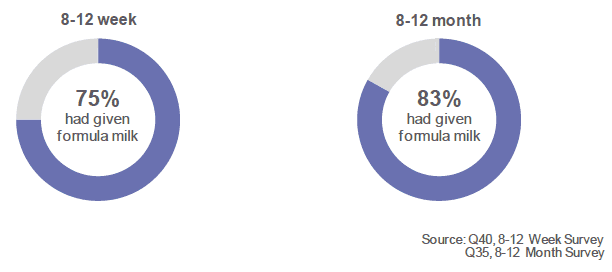
Source: Q40, 8-12 Week Survey
Q35, 8-12 Month Survey
However, the results for the 8-12 month survey should be treated with caution. Some respondents who had given breast milk said that their baby had been "fully formula fed from birth", while some respondents who had not given any breast milk said that their infant had been given "some formula". [31]
Given that 24% of 8-12 month survey respondents stated that their baby had never been given any breast milk, it may be more accurate to say that 24% of respondents had infants who had been fully formula fed since birth.
6.2 Making-up infant formula feeds
Guidelines are available for the use of formula milk to ensure that it is prepared properly and safely. ( R11, R23) Formula powder is not sterile and, although rare, may contain bacteria can that cause infections and make an infant seriously ill. Current advice for making up powdered infant formula milk is as follows:
- Bottles should be made up freshly, one at a time, and any leftover formula should be thrown away.
- Feeds should be made using cooled boiled water that is still hotter than 70°C. In practice, this means filling the kettle with a litre of water (water that has not been boiled before), boiling and leaving to cool for no longer than 30 minutes.
- When access to freshly boiled water is difficult ( e.g. when outside the home), it is recommended that a vacuum flask of hot water is used to make up the feed as required.
- Water should be added to the bottle before the milk powder.
Manufacturer's instructions for making up formula milk should always be followed.
Making up feeds
All respondents to the 8-12 week survey who indicated that they had used infant formula, either exclusively or in combination with breast milk, were asked about how they usually made-up feeds.
- 9% said that they only ever used ready to feed formula.
- In line with guidance for powdered formula, the majority of respondents (71%) indicated that they only made one feed at a time. However, one in ten (11%) reported making several feeds at a time.
- The remaining 9% of respondents did not specify how they usually made up formula feeds; these were primarily mothers who said that their infant had been given formula only once or twice, or a few times (see Figure 5.21)
[ Figure 6.2; Table 6.2a]
Respondents, who indicated that they made either one or several feeds at a time, were asked for further details:
- The majority (82%) followed current guidance and used water that was either just boiled or that had been boiled and left to cool for 30 minutes or less. Around one in ten respondents (9%) used water that had been left to cool for more than 30 minutes, while a small percentage (1%) used water that had not been boiled at all. [32]
- When feeding away from home, 32% of respondents said that they used ready to feed formula. Twenty-three percent (23%) used freshly boiled water or boiled water from a flask (in line with current guidance). A quarter of respondents (25%) made up a bottle before leaving home, while 9% used cold water or cooled boiled water.
- When making infant formula, the majority of respondents (91%) reported that they put the water in the bottle first and then added the powder.
[Figure 6.2; Table 6.2b]
The majority of respondents followed current guidelines for making-up infant formula, but some did not.
Figure 6.2: Making up infant formula feeds (Percentage of respondents who selected each response to each question. Respondents who had given infant formula).
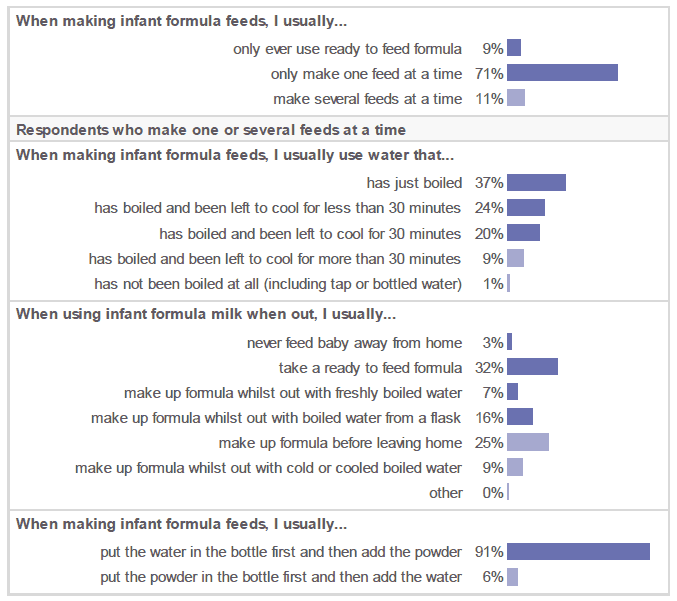
Source: Q47 - Q50, 8-12 Week Survey
6.3 Methods of cleaning and sterilising bottles and teats [33]
Current guidance states that all feeding equipment for infants should be cleaned and sterilised to protect against infection. Equipment should be sterilised until the infant is 12 months old. ( R11, R23)
Equipment should be thoroughly cleaned using hot soapy water and rinsed under clear running cold water before sterilising. A dishwasher can be used, but equipment must still be sterilised afterwards.
Recommended methods for sterilising are cold water sterilising (in a sterilising solution), steam sterilising (electric or microwave) or boil sterilising (boiling water).
Cleaning bottles and teats
The majority of 8-12 week survey respondents (83%) reported that they used hot soapy water to clean their baby's bottles and teats. Twenty-one percent (21%) indicated that they rinsed bottles and teats under the tap. Only 5% of respondents reported using a dishwasher. Eight percent (8%) of respondents did not specify a cleaning method.
[Figure 6.3; Table 6.3]
Most respondents used hot soapy water to clean their infant's bottles and teats.
Figure 6.3: What method(s) do you usually use to clean bottles and teats? (Percentage of respondents who selected each method. Respondents who had given infant formula).
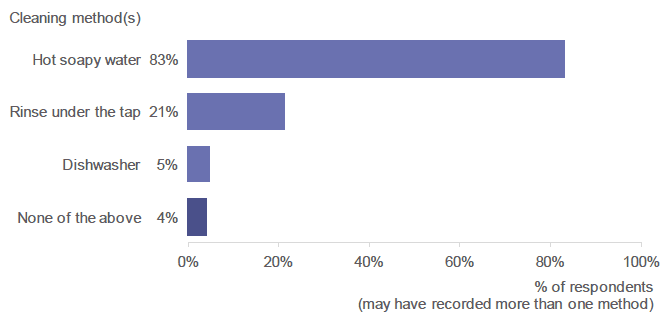
Source: Q51 , 8-12 Week Survey
Sterilising bottles and teats
The most popular method of sterilising bottles and teats was with a steam steriliser (59%). Microwave sterilisers were also used frequently (28%). Only 13% of respondents reported using sterilising solution and 8% indicated that they boiled the bottles in water. Seven percent (7%) of respondents did not specify which method of sterilisation they used.
[Figure 6.4; Table 6.4]
Most respondents used a steam steriliser to sterilise their infant's bottles and teats.
Figure 6.4: What method(s) do you usually use to sterilise bottles and teats? (Percentage of respondents who selected each method. Respondents who had given infant formula).
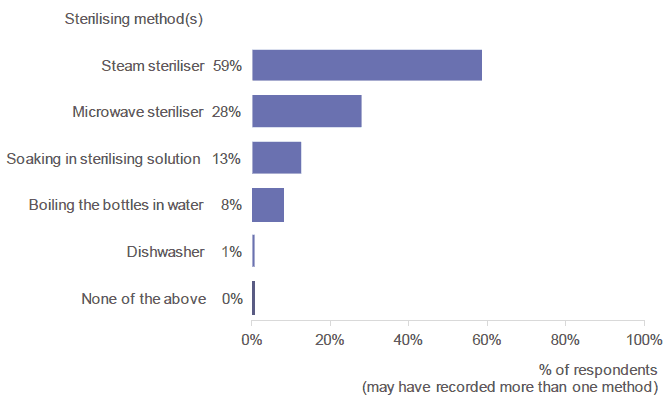
Source: Q52 , 8-12 Week Survey
6.4 Types of formula and other types of milk given
Where a mother chooses to formula feed, current guidance is that infant formula milk should be used until the baby is 12 months old. ( R11, R23)
- Infant formula milk (or first stage formula) is suitable for use from birth. After 12 months a baby can begin drinking full fat cows' milk.
- Second stage milk / follow-on milk is not suitable for babies who are younger than six months old. While infants over six months of age can be given second / follow-on milk, there is currently no recommendation for families to switch to this type of formula.
Other specialised formula types may be recommended based on medical or dietetic advice.
8-12 week survey: types of formula milk given in the last seven days
- Amongst respondents to the 8-12 week survey who had ever given their baby formula milk, the majority of mothers reported that their baby had been given infant formula in the last seven days (82%). Two percent (2%) reported that their baby had been given second milk or a follow-on formula.
- Four percent (4%) of respondents reported that they had given their baby another type of milk in the last seven days. This included specialist milks that can be bought over the counter ( e.g. anti-reflux milk) and milks that may be prescribed by a doctor ( e.g. milks suitable for babies with a cows' milk allergy).
- Fourteen percent (14%) of respondents did not specify which types of formula milk had been given in the last seven days; these were primarily mothers who said that their infant had been given formula only once or twice, or a few times (see Figure 5.21 above).
[Table 6.5]
8-12 month survey: types of formula milk ever given
- Respondents to the 8-12 month survey who had given their baby formula milk, were asked what types of formula milk their baby had ever received. Nearly all respondents (92%) reported that their baby had been given infant formula, while 15% had been given second milk and 13% a follow-on formula.
- Seven percent (7%) of respondents reported that they had given their baby another type of formula milk. Again, this included specialist milks available over the counter and milks that are medically prescribed.
- Only 1% of respondents said that their baby had been given a soya infant formula.
[Table 6.6]
6.5 Use of second milk / follow-on formula
Postnatal survey respondents who had given any type of formula milk to their baby were asked if their infant had ever been given second milk or a follow-on formula.
Amongst respondents who had ever given formula: [34]
- Only 2% in the 8-12 week survey reported that their baby had been given second milk or a follow-on formula.
- 31% in the 8-12 month survey reported that their baby had been given second milk or a follow-on formula.
[Figure 6.5; Table 6.7a & 6.7b]
Amongst 8-12 month survey respondents who had ever given their infant any type of formula milk, nearly a third reported that their baby had been given second milk or follow-on formula.
Figure 6.5: Has your baby ever been given a second milk or follow-on formula milk? (Percentage of respondents who indicted that a second milk / follow-on formula had been given. Respondents who had given infant formula).
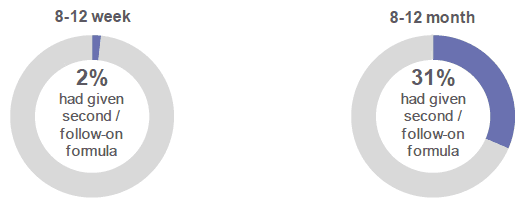
Source: Q54, 8-12 Week Survey
Q37, 8-12 Month Survey
Amongst the small number of 8-12 week survey respondents who reported that their baby had been given second / follow-on milk, nearly half (47%) indicated that this was on the advice of a health care professional. It is thought that some respondents may have been unsure of the differences between the various types of formula.
8-12 month survey: use of second milk / follow-on formula
The majority of respondents to the 8-12 month survey, who had given their baby second milk or follow-on formula, reported that their infant had been at least six months old when it was first given (88%). However, 11% of these respondents indicated that it had been given before six months.
Again, it is thought that some respondents may have been unsure of the differences between the various types of formula.
[Figure 6.6; Table 6.8]
The majority of 8-12 month survey respondents who had given their infant second milk / follow-on formula waited until their baby was at least six months old.
Figure 6.6: How old was your baby when he/she was first given second milk or follow-on formula? (Percentage of respondents who recorded each age. Respondents who had given second milk / follow-on formula).
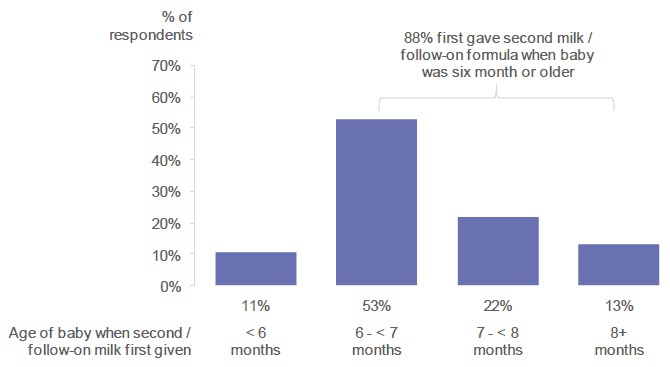
Source: Q38, 8-12 Month Survey
8-12 month survey: reasons for giving second milk / follow-on formula
Overall, the most common reason reported for giving second milk or follow-on formula was the belief that it would be better for the baby / contained more nutrition (48%). Previous experience with another baby was another frequently given reason (20%).
Amongst respondents who had introduced second milk or follow-on formula before their baby was six months old, 26% indicated that they had done so because their baby was waking up during the night. Advice from a health care professional (23%) was also a frequently reported reason given by group of respondents.
[Figure 6.7; Table 6.9]
Nearly half of respondents who had given second milk or follow-on formula had done so because they thought it would be better for the baby.
Figure 6.7: What were the reasons you decided to give second milk / follow-on formula to your baby? (Percentage of respondents who selected each reason, by age of baby when first given. Respondents who had given second milk / follow-on formula. Most common reasons highlighted).
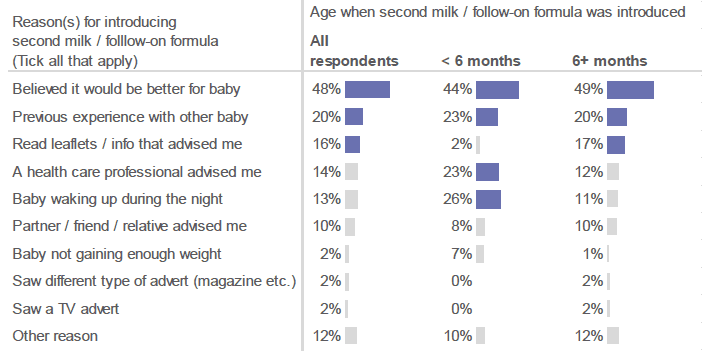
Source: Q39, Q38, 8-12 Month Survey
Contact
There is a problem
Thanks for your feedback